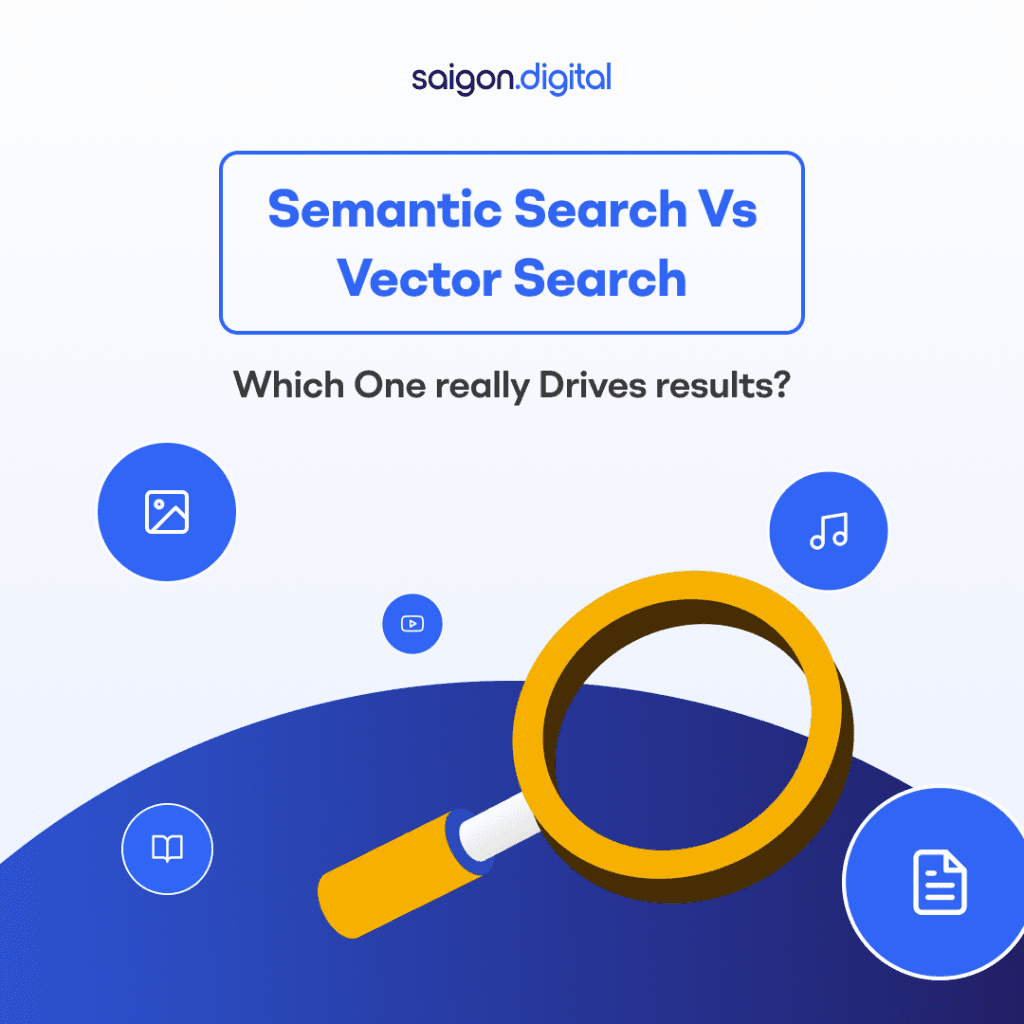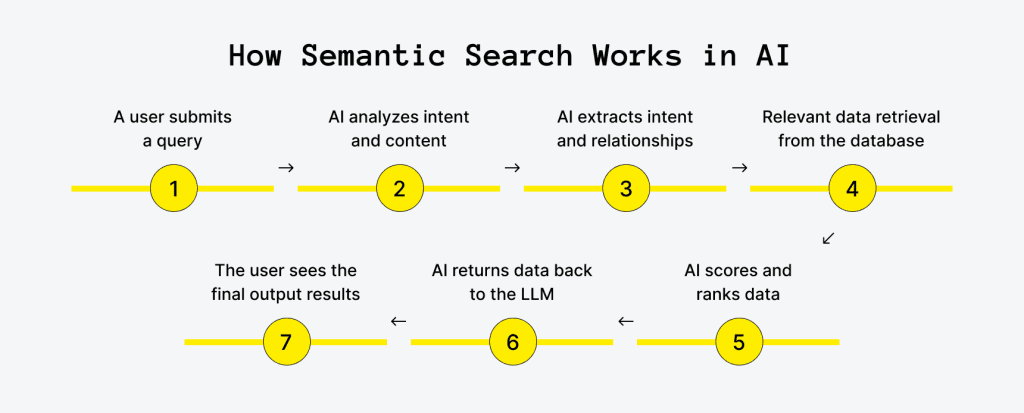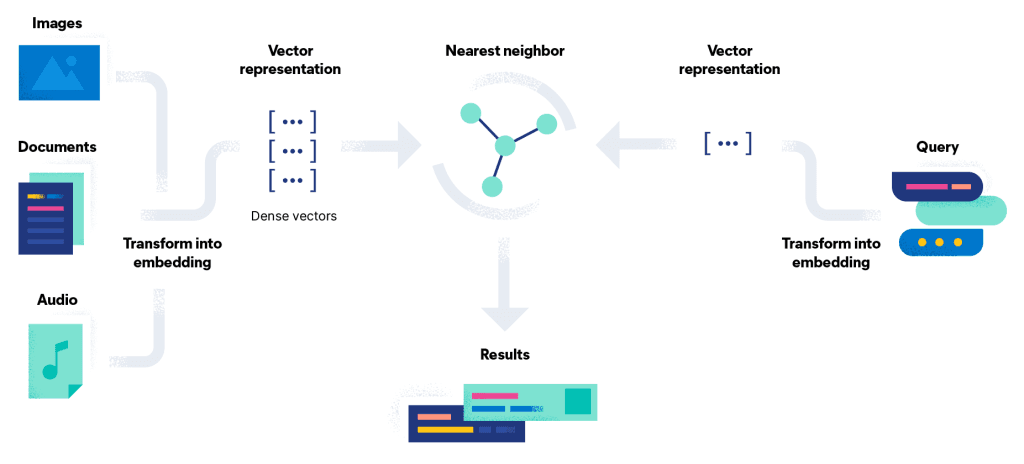
What Is Semantic Search?
To understand how search has evolved beyond simple keyword matching, we first need to explore semantic search, which is a key innovation shaping how users find information online today. Let’s break down how this works and why it matters for modern SEO.The Concept in a Nutshell
Semantic search refers to search engines’ ability to understand meaning, context and intent, not just literal keyword matching. Traditional (lexical) search might match your query words with documents that contain exactly those words. Semantic search goes further: it tries to interpret what the user means which includes their intent, synonyms, relationships, and even latent connections. In practice, semantic search uses techniques from natural language processing (NLP) and knowledge representation (e.g. knowledge graphs, entity linking) to go beyond pure keyword matches.
A Simple Example
Suppose a user types: “best places to eat near me with vegan options” A pure keyword-based engine might prioritise pages that contain “best”, “places”, “eat”, “vegan”. But a semantic engine could infer that:- The user is looking for restaurants (places to eat).
- They care about “near me” (location context).
- They explicitly want vegan choices, so pages about generic restaurants won’t suffice unless they mention vegan.
- It might surface pages like “top 10 vegan restaurants in District 1, HCMC” even if their page title is “Green Table – vegan Vietnamese dining”.
Where Semantic Search Shines
- Disambiguation: It can distinguish between “apple the fruit” vs “Apple the company” given context.
- Synonym / paraphrase handling: It understands that “purchase” and “buy” are related.
- Query expansion / inference: The system might infer latent meaning (e.g. “headache remedies” when someone asks “how to stop throbbing in temple”) using domain knowledge.
- Sophisticated Q&A or voice search: In these contexts, understanding nuance is critical.
What Is Vector Search?
As search technology continues to advance, vector search has emerged as a powerful approach that allows systems to retrieve information based on similarity in meaning rather than exact wording. This innovation forms the backbone of many modern search and recommendation systems, setting the stage for a deeper understanding of how users think and search.The Concept in Brief
Vector search (also sometimes called embedding-based or similarity search) is a method of retrieving items (documents, sentences, images) by converting them into high-dimensional numerical vectors (embeddings). A user query is also converted into a vector, and the system finds “neighbouring” vectors (by distance or similarity metrics such as cosine similarity, Euclidean distance) to find items semantically close to the query. In essence, vector search enables us to search by meaning (in a mathematical embedding space) rather than by literal string matching.
An Everyday Analogy
Imagine embedding each document (or sentence) as a point in a multi-dimensional space. Documents that are about similar topics lie close to each other in that space. If a query is also embedded, the system returns documents whose vectors are near that query vector. For example, say you have embeddings for:- “How to grow strawberries in Ho Chi Minh City”
- “Berry farming in tropical climate”
- “Strawberry cultivation tips”
- “Vietnam cuisine recipes”
Advantages and Trade-offs
Pros:- Scalability and speed: Vector search engines (or vector databases) with efficient indexing can handle very large datasets and retrieve nearest neighbours quickly.
- Flexibility and multimodality: They can be extended to non-text data (images, audio) by embedding them into vector spaces too.
- Similarity retrieval: Excellent for “give me things like this” queries (recommendation, semantic matching).
- Context limitations: Embeddings may fail to capture subtle nuance, or misinterpret context, especially if the embedding model is not well tuned.
- Quality depends heavily on embedding model: Poor embeddings result in poor retrieval.
- No inherent concept of relational structure: Unlike knowledge graphs, vector space doesn’t encode explicit entity relationships (e.g. “Is a” or “part of”) unless learned implicitly.
Semantic Search vs Vector Search: How They Relate (and Differ)
It is common today to see these terms conflated or used interchangeably. In practice, vector search can be a component or enabler of semantic search, that is, semantic search systems often rely on embeddings and vector similarity under the hood. Here are core differences and relationships: Aspect Semantic Search Vector Search Focus Meaning, intent, context, relationships Similarity in embedding space Approach NLP pipelines, possibly knowledge graphs, entity linking Embedding models + vector similarity search Precision in nuance Stronger in complex queries Good for general similarity, less perfect in edge nuance Scalability More challenging, depending on architecture More scalable via optimized vector indexing Multi-modality Primarily text (though can be extended) Naturally supports multi-modal embeddings Role End-to-end search paradigm A core retrieval component / tool Some practitioners remark that what companies often call “semantic search” is really vector search plus extra ranking layers (e.g. keyword boosting, entity weighting). Thus, it’s helpful to think of semantic vs vector not as opposing but as layers in the modern retrieval stack.Which One Drives Results in SEO (or: What Matters for Ranking)?
Now that we’ve defined both sides and their interplay, the crucial question: Which of the two, semantic search vs vector search, really drives SEO outcomes? The short answer is: neither alone guarantees SEO success . What drives results in SEO is alignment with user intent, content relevance, comprehensiveness, structure, authority, UX, and signals that search engines value. But semantic and vector techniques are tools that, when deployed wisely, improve your chances. Below, we examine how each affects SEO, and then argue for a hybrid or integrated approach.How Semantic Search Influences SEO
1. Relevance and intent matching
If your content truly addresses the search intention , not just keyword matches, you are far more likely to rank well when search engines interpret queries semantically. For instance, users may type 10 different queries that all mean “how to fix a leaking roof in HCMC” which a semantically-aware engine can then map them to the same set of pages.2. Synonyms / Paraphrases
Semantic systems help engines recognise that “overnight oats recipe” and “how to make oats overnight” are the same intent. This helps your content compete across variant phrasings without you having to manually target every permutation.3. Contextual ranking / entity linking
If your content is rich in entities (places, people, products) and relationships, a semantic engine can reward deeper, schema-rich content. For example, pages that link concepts (“Saigon Digital solution for semantic search”) may be favourably interpreted.4. Featured snippets, knowledge panels, answer boxes
Because semantic systems feed knowledge graphs and structured data, well-structured content (with question and answer format, schema markup , entity consistency) stands a better chance of triggering SERP features. In short: semantic alignment helps Google (or Bing) understand your content more richly, which improves chances for correct ranking and features.How Vector Search Plays a Role in SEO
At first glance, vector search seems more relevant to internal search engines or recommendation systems than to SEO. But some emerging SEO and search architectures increasingly incorporate vector techniques:1. Search engine retrieval pipelines
Modern engines may use embedding-based retrieval (vector search) as a first-stage filter before applying ranking models. In that sense, being “close” in vector space to likely queries can help your document get into the candidate set.2. Semantic similarity scoring
If Google or other engines generate embeddings for queries and pages, your content’s embedding proximity to the query vector might impact ranking.3. Content recommendation / internal site search
On your site, vector-powered search may help deliver more relevant internal linking and content discovery, indirectly helping SEO through engagement metrics. However, the direct impact of vector search on SEO ranking is less obvious (at least publicly documented). Most SEO best practices today still revolve around semantic understanding more than raw embedding similarity.Why Hybrid / Layered Approaches Win
Given the strengths and limitations of both, many practitioners and systems adopt hybrid search models:1. Vector-first retrieval, semantic re-ranking
The system first uses vector similarity to fetch a candidate set (fast, scalable), then applies semantic ranking (using intent, entity weights, domain knowledge) to choose the final top results.2. Keyword + semantic + vector fusion
Some pipelines combine classic keyword (lexical) signals (e.g. BM25), semantic signals (intent, entity match) and vector similarity scores, merging them into a final score.3. Intent classification + vector search within intent buckets
First classify query into intent cluster (informational, navigational, transactional), then use vector search within those clusters to pick the best content. This hybrid approach tends to capture the best of both worlds: the semantic depth and nuance, and the speed and scalability and embedding-based relevance. From an SEO perspective, this means: create content that is semantically rich, topically authoritative, well structured, and aligned with user intent, while letting modern retrieval architectures (vector + semantic) more easily pick up your pages as relevant candidates.Key Factors that Truly Drive SEO Results
Even the best retrieval tech won’t rescue content that lacks core SEO fundamentals. To drive results:- Content depth and topical authority: Cover a topic comprehensively, including subtopics and related queries.
- User experience and engagement: Low bounce rates, good dwell time, internal linking, fast loading.
- Semantic structure and markup: Use headings, schema.org, entity linking, FAQs, structured data.
- Internal and external link signals: Build relevance and trust via links.
- Freshness / updates: Keep content current if the topic demands.
- On-page and technical SEO: Titles, meta descriptions, canonical tags, site architecture.
Practical Advice: How Saigon Digital Would Apply This
To make this less abstract, here is how we (at Saigon Digital) would approach integrating semantic and vector insights into your SEO and content strategy.1. Topic Modelling and Clustering Via Embeddings
We might embed your existing content (and competitor content) and cluster them to see thematic gaps or overlaps. This gives us insight into content clusters, which topics are closely related but perhaps underexplored.2. Semantic Content Planning
For each content cluster, we build content briefs anchored in semantic intent: what questions will users ask? What related entities or concepts should be covered? As well as what meaning beyond keywords matters? This ensures we don’t write to keywords alone, but to intent.3. Optimization of Content for Semantic Understanding
- Use entity linking (mention and link key concepts)
- Use schema / structured data
- Use question/answer patterns, FAQs
- Use synonyms and related terms naturally
- Ensure logical structure and clarity





